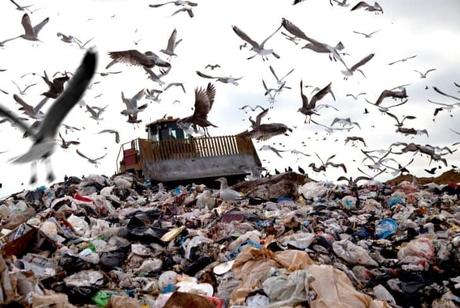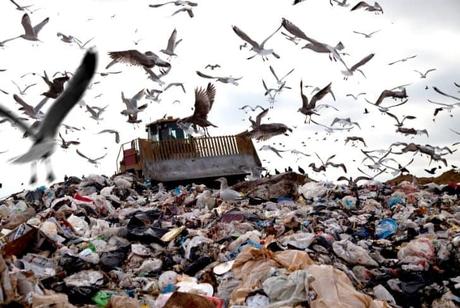How Do Landfills Contribute to Global Warming?
Environmental wastes constituting both organic and inorganic materials that are derived from homes and industries go directly to landfills. Now, proper managing the landfills will result in the production of methane and other greenhouse gases, which has tremendous utilities.
These gases contribute to global warming and other environmental hazards, but if managed effectively, they can also serve various useful functions. Let’s find out and discuss how landfills contribute to global warming.

How Much do Landfills Contribute to Global Warming?
Landfills are generally kept in places under the ground lined with clay and enveloped in a sheet of plastic that is flexible in nature. There are some drains and pipes kept for collecting the liquid that seeps easily from the trash. The liquid, which is mostly leachate, is a contaminated fluid and treated as wastewater.
In modern times, the landfills require fresh addition of soil every day until they reach the trash and get covered with clay, and finally a plastic sheet.
The trash placed inside a landfill is stored and then decomposed slowly in the absence of oxygen. The bacteria that are found in organic waste help to decompose, and then it emits a gas called methane, inflammable and highly dangerous if it’s allowed to collect underground.
Methane, also popular as a potent greenhouse gas that is 25 to 72 times potent than carbon dioxide, which ultimately contributes to global warming. Most of the organic trash is made from food and paper, which testifies the fact that methane has a high potential of emitting.
A study done in the last decade reveals that around 7 billion residents living in this world contribute 1.2 kgs waste per head, which ultimately amounting to 1.3 billion tons per year. By 2025, it almost rises to 2.2 billion per year, and nearly 60 percent of this ends up in landfills.
Modern landfills collect methane gas through pipes for useful purposes like transport, manufacturing and electricity generation. This is the most welcoming fact for the best practice of the industry, although it doesn’t reflect the ground situation.
Reducing the emission of greenhouse gases could be effective in mitigating global warming, but the emission of methane gas from landfills is also very significant. The study revealed in 2002 says that greenhouse gas emissions from wastes are the highest in North America, Europe, Japan, Australia, and New Zealand.
Why are Landfills Bad For the Environment?
The products used by people are thrown away on a regular basis, which contains toxic chemicals. The products end up in landfills or incineration, which pollutes the air and the water hugely. In 1988, the EPA pointed out the fact that all landfills will eventually leak, which includes the runoff from industries carrying toxic chemicals, waste ends and water supplies.
Studies reveal that methane is emitted from landfills and is multiple times potent than carbon dioxide, thereby known as a powerful contributor to our contemporary environmental crisis.
Harmful gases from landfills result in birth defects, apart from other serious problems. Even the post-closure of landfills can result in subsequent leakage of facilities that are used as parking lots, playgrounds, and athletic fields. Incinerating our wastes leads to the production of toxic chemicals like lead, mercury, dioxins and furans. They produce toxic ash, and these are all present in landfills.
Incinerators are the common practice of producing waste to energy, and it releases many pollutants in this process. Communities are faced with health issues like cancer and respiratory diseases. Gasification might be considered green as they allow energy from waste, but toxins are released into the air in this process.
Sludge generated by wastewaters is often used as fertilizers on field, gravel and forestry lots. They contain a measurable amount of pollutants like heavy metals, dioxin and other toxic materials. The presence of pathogens like bacteria, viruses, human germs and parasites can make it detrimental for human health. Sludge odor is considered a nuisance and a public threat to health. This may lead to respiratory problems as well as death.
The landfill contains gases like nitrogen and hydrogen sulfide, which can cause coughing, irritation of eyes, nose, throat, nausea, and other breathing difficulties. The reported health complaints with humans include headache, nausea, skin irritation, weight loss, sleeping difficulties, nasal blockage, chest pain and aggravation of asthmatic conditions.
There are also several other health hazards associated with methane and carbon dioxide like fatigue, nausea, vomiting and unconsciousness. The fact that older landfills might not have features of gas control can make the situation even worse.
Are Landfills Contributors to Greenhouse Gases?
While you take out your trash, you feel lighter. But the landfill where all your food and trash are decomposed, it might be a contributory factor to methane, a potent greenhouse gas. The gas is multiple times more potent than carbon dioxide, which contributes to smog, and other health worsening factors.
According to a study, globally, the trash released is about 800 million metric tons, which is almost 11 percent of the methane gas produced by humans. According to a survey made in 2010, the US has the highest amount of methane emissions in the world. This is accompanied by other countries like China, Mexico, Russia, Indonesia, Canada, the UK, Brazil and India. The study was done according to the Global Methane Initiative, a partnership of the Government and private groups aimed at reducing methane emissions.
The landfills go through various stages like open or open with a cover that lets in some oxygen or might be closed with an impermeable seal. When the landfill is sealed, it has released most of the methane and thereby contributing to greenhouse gas emissions. According to the EPA estimates, the landfill gas energy captures 60-90 percent of methane emitted.
Landfills are a significant source of methane, the most efficient gas to greenhouse emissions. Biosolids are used for the creation of very special topsoil to cover the decommissioned landfills. Topsoil is known to contain microorganisms, converting methane to carbon dioxide, which is a greenhouse gas with lesser potential.
There are various arrangements to reduce greenhouse gas emissions to a large extent. Due to the aerobic and anaerobic degradations, greenhouse gases like methane, carbon dioxide, and nitrogen dioxide are produced from the landfill, which contributes directly to global warming. Even the leachate system contributes to the addition of greenhouse gases.
The amount of gas emissions from the landfills are influenced by various factors like organic content, moisture, temperature, landfill volume and the age of the waste.
How is Methane Gas Produced in Landfills?
The production of methane occurs in landfills when organic matters decompose, thereby rotting the protein part. The anaerobic reaction occurs, and the Ammonia, Sulphide gas emits, thus combining with carbon dioxide and producing methane gas. The combination of carbon with hydrogen forms methane. Considering Europe alone, the landfill has the potential of generating 94 billion cubic meters of methane each year.
Methane is generally extracted by extracting sinking pipes or wells into the landfills and then sucking the gas out of it. There is no need for oxygen as that would prevent the process of anaerobic degradation. Generally, the landfills are covered with a membrane that prevents oxygen from entering the place.
The permeable layer remains sandwiched between the two semipermeable layers of clay inside the landfill. The idea is to allow the carbon dioxide inside the landfill to move slightly above the atmospheric pressure. There is a creation of a barrier preventing the drawing up of oxygen inside the landfill.
Methane is sucked out of the ground, and carbon dioxide is being sucked inside the landfill. After closure also, a landfill will produce methane for the next 15 to 20 years. Later, the methane is pumped out, and the carbon dioxide is forced inside that enables the production of methane or greenhouse gas.
This sort of production of methane from landfills is quite prevalent, and they are used to power vehicles or heat up the nearby buildings. In countries like the UK, the methane produced from landfills is used as a fuel for buses.
Many procedures are coming up that prevents the emission of greenhouse gases (GHG) from landfills. Replacing methane with carbon dioxide will probably reduce the emission of gas to a large extent and also global warming effectively.
Resources:
https://www.health.ny.gov/environmental/outdoors/air/landfill_gas.htm
https://communityactionworks.org/issues/waste/
https://study.com/academy/answer/how-do-landfills-contribute-to-global-warming.html


